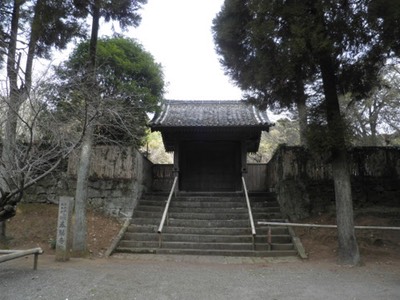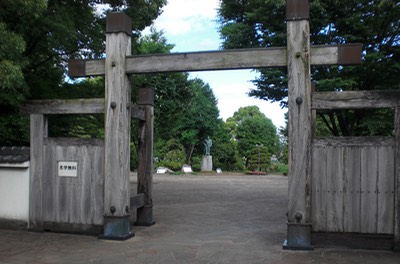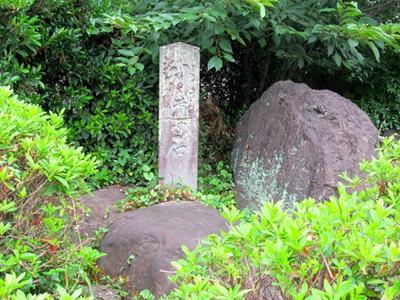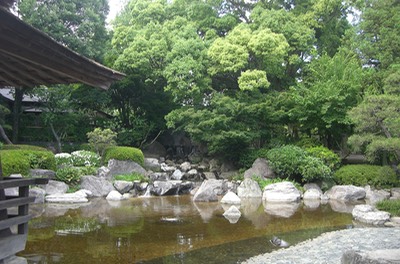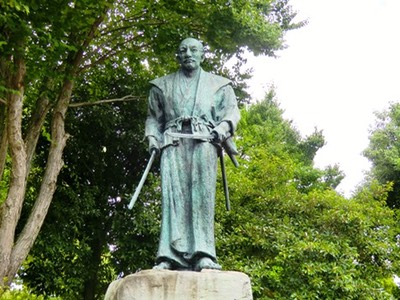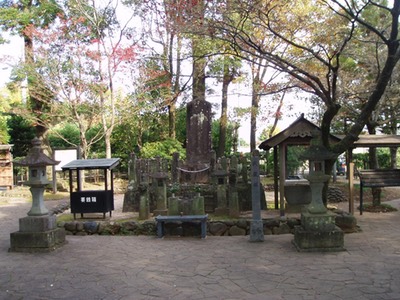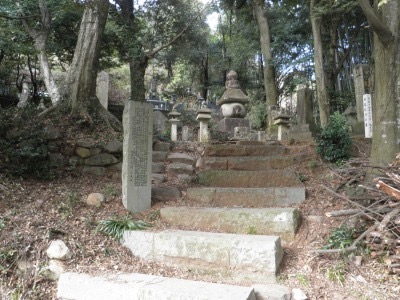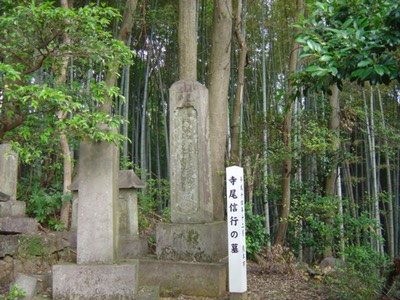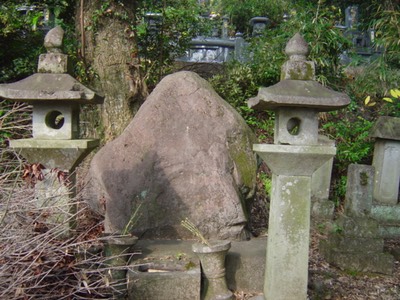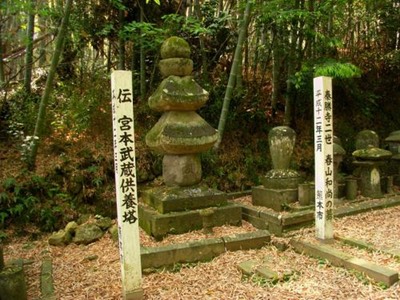As if to illustrate the eagerness with which various groups seem to claim Musashi’s heritage, even the place where the great swordsman is supposed to be buried is contested. Fact is that Musashi died in the vicinity of Kumamoto on 13 June 1645. However, it is not clear where exactly his remains were interred on his funeral, whether they were later moved, and where they are currently resting.
According to his son’s correspondence, Musashi’s burial ceremony was conducted by Daien Oshō, the first abbot of the Taishō temple, which was the family temple of the Hosokawa clan in Kumamoto. According to the Bukōden, however, an important role is ascribed to Akiyama Wanao (1618–73). Wanao was the temple’s second abbot, and is believed to have befriended Musashi during his last years in Kumamoto:
卒去の時、遺言の通り、甲冑を帯し六具を固めて入棺であった。飽田郡小江村の地に埋葬した。かねての約束で、泰勝寺の前杉馬場の内に棺を舁ぎ据え、春山和尚が出迎えて、引導した。これはみな遺言によってのことである。
On his death Musashi was laid in his coffin in full armor with all his weapons, as he had requested. He was buried in the village of Oe in the Akita district. As was previously arranged, the coffin was brought to the Maesugi horse grounds of the Taishō temple, where Akiyama Wanao performed the last rites.
Today, neither the village Oe nor the district of Akita any longer exist, as the village has been swallowed up by Kumamoto’s suburbs, while the district of Akita was abolished as a result of land reforms during the Meiji era. In Musashi’s day, however, the village of Oe (小江) was situated somewhere on the eastern banks of the Shira River, only a mile or so from Kumamoto castle. Spelled with a different initial character, this part of Kumamoto is now called Ōe (大江).
The Maesugi horse grounds were at the southern entrance to Taishō temple compound. It was there that the procession was brought to a halt, that Musashi’s coffin was placed on a large rock along the right side of the road leading down to the river, and that Akiyama Wanao said a requiem for his departed friend. The rain season had started and it was pouring down with rain, and it is said that no sooner had Wanao performed the last rites, than a massive bolt of lightning lit up the grey sky. Today, the Maesugi horse grounds have been swallowed up by Kumamoto’s urban sprawl, but the stone, marked by a pylon, is still in situ.
According to the Heihō senshi denki Musashi’s remains were (at some stage) recovered from the grave in Higo and transferred to Kokura “on the request of Ogasawara Tadazane, who thought it more fitting that Musashi be berried in Kokura, near the rest of his descendants.” If Musashi’s remains were indeed transferred to Kokura, it is more likely that this was done by his son, Iori, when, in 1654, on the tenth anniversary of his father’s death, he erected a monument on the crest of Temukeyama, a small hill on the outskirts of Akazaka.
It might have been at that juncture that Iori had Musashi’s tombstone in Kumamoto moved to a village called Yuge, on the opposite bank of the Shira River, some five miles upstream. Yuge was situated along the Ōzu Kaidō, the old high road that connected Kumamoto the rest of Japan. Called Musashizuka, or the Musashi burial mound, it is today located in the Ryūta township in Kumamoto’s Kita (northern) ward. Now known as Musashizuka Park and graced with a life-size statue of the swordsman, the site is now widely recognized to be Musashi’s true gravesite and as such is visited by thousands of Musashi aficionados every year.
There is however, yet another contender for the claim to be Musashi’s burial site. This is what has come to be known as the Nishi no Musashizuka, or the western Musashi burial mound, as it is situated in Kumamoto’s western Shimasaki ward. This mound is the known grave of Terao Motomenosuke Nobuyuki (1621–88), one of Musashi’s most trusted followers. Engraved with the inscription Shingen koji, or Buddhist layman Shingen, a withered rock flanked by two lanterns is believed by some to mark the true place where Musashi’s remains rest until this day.
Finally, there is one more site erected in the wake of Musashi’s death. Hidden away on the verdant ground of the former Taishō temple, it is situated next to the grave of Akiyama Wanao, and flanked by a narrow concrete pole reading “Miyamoto Musashi kyōyō-tō” (tower for the repose of Musashi’s spirit). In fact it is a traditional gorintō still widely used for memorial monuments and toms throughout Asia.
The gorintō is assembled of five differently shaped stone segments, each placed on top of each other and each carrying a deeply symbolic meaning: the square foundation stone at the base represents the four elements; the hemispherical dome represents the attainment of wisdom; the conical spire represents transition to enlightenment; the crescent moon represents one’s receptivity to the teachings of heaven, and the circular disc at the pinnacle represents perfection through the fusion of wisdom and principles and thereby Buddha-hood.
On another symbolic level, the five segments represent the different stages of progress in a student’s spiritual progress: the will to perfection in the square basis, the attainment of equanimity in the hemispherical dome, the pursuit of truth in the conical spire, the development of awareness and intuition in the crescent moon, and finally perfection in the circular disc. Significantly, here, the five segments also represent the five elements of earth, water, fire, wind, and heaven—the five elements of Musashi’s seminal work, the Gorin no sho, the Book of Five Rings.
Any queries of remarks? Launch or join a discussion at our new FORUM
